“Accidents happen” and “safety first” are clichéd terms that hold serious implications in the tradeshow industry. When accidents happen during installation or dismantle on the show floor, they can be life-changing. Yet, they rarely are reported.
For the most part, the tradeshow floor is a world of controlled chaos, but it only takes a split second of misjudgment to become life-threatening. Working in the Las Vegas convention industry for 20 years, I have seen catastrophic events alter the lives of more than a few co-workers.
New to the industry in 1992, I met a man who lost his left arm completely after it was crushed between two pieces of freight. He wore a hook in place of that arm for all the years I knew him. In the mid ‘90s, a woman who was working behind a drape suffered impalement to the back of her head by a forklift tine raised too high. Her life was changed completely, and she never fully could return to work. In another incident, a decorating foreman had a piece of freight dropped on her that crushed the bones in her face.
Earlier this year an eight-ton computer sever fell on a young man, breaking his neck and back at the Sands Expo and Convention Center. Most recently, a condor ran over a man’s foot at SEMA 2012. After a brief hospital stay and multiple pins, he is getting around again.
Although no one really likes to talk about safety, it is an area that needs to be addressed in the convention industry. Over the years, procedures have advanced and far less incidents are heard of. Some new implementations are the result of trial and error, while other times, prevention has championed the cause through innovative safety strategies.
One such strategy is being implemented by the Teamsters union Local 631 in Las Vegas. They created a training trust and apprenticeship program in an effort to reduce industrial accidents and provide an educated workforce.
Instructors receive their qualifications through Occupational Safety and Health Administration (OSHA)-accredited classes as well as years of experience on the show floor. Workers are empowered by the procedural knowledge taken to the show floor, and a better trained work pool has significantly changed the face of best-practices in the industry, according to Tim Koviak, business agent for Local 631.
“The training center is not just for apprenticeship; it’s for journeymen, too,” said Koviak. “It’s a place for journeymen to hone their skills and reinforce safety. We’re trying to train our industry to be the best in the nation, and with that training comes safety.”
The training trust also offers OSHA general-industry safety classes, machinery-certification classes and instruction in first aid and CPR.
“We’ve done a lot of things to bring up safety levels,” said Koviak. “It’s not where we want it to be, but it’s moving in the right direction.”
On the show floor, safety reminders also are getting harder and harder to miss.
Freeman, producers of more than 15,000 events annually, is known for its safety policies. The company frames its rules at the beginning of every work shift with a safety speech given to employees by the department foreman These pre-shift reminders serve a purpose to cement the policies in the minds of employees each day.
Another common practice seen by general contractors is sign-posting. These conspicuously positioned reminders, usually posted during setup, keep safety procedures on the mind of exhibitor and union labor on the show floor. All the while, company-appointed safety coordinators patrol the show enforcing and educating workers about policies.
The tradeshow atmosphere, especially on a long setup, can try the strength and staying power of even the experienced worker. It’s an endurance race where the tired can make mistakes, but education has proven to be an effective prevention practice, not just in Vegas, but everywhere.
Czarnowski took the bull by the horns in Miami, bridging the gap between the Sign and Display Local 1175 and the Miami Beach Convention Center to highlight safety, according to a recent Exhibitor News Network article. The joint-training program focused on injury and accident prevention.
“The best way to create an environment where safety is the biggest priority is through proper training and by creating a team out of the parties most involved with and affected by this issue,” said Bob Balsam, general manager of the Miami Beach Convention Center.
On the opposite coast, the Trade Show Safety Professionals (TSSP) in Anaheim, Calif., is a membership-based coalition of convention-safety specialists. They offer safety counseling to companies of all sizes regardless of affiliation.
“We’re trying to unite tradeshow professionals across the country to work together for a common good,” said Ian Wright, president of TSSP. “We want to establish best-practice policies nationwide.”
TSSP is partnering with convention centers, fairgrounds, civic centers, hotels and other venues in developing safety standardization techniques.
The convention industry has made noteworthy collective strides. But accidents happen, and industry professionals must continue to put safety first when they are on the show floor. After all, “safety is job one,” said Koviak.































